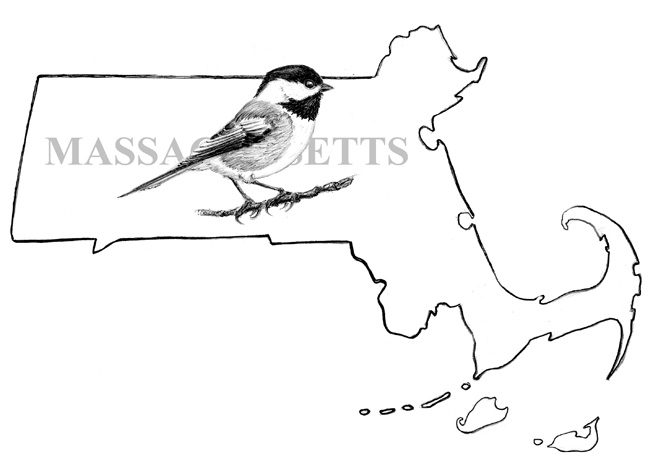
Dear Bird Folks,
I’m aware that the Black-capped Chickadee is the state bird of Massachusetts, but I’d like to know who determines which bird is chosen to be the official bird of a state?
– John, Falmouth, MA
This was scary, John,
Did you ever find out a piece of information that you wished you didn’t know, like, say, your grandparents were Bonnie and Clyde, or worse…Yankee fans? After I read your note about state birds I did a little research and I wasn’t happy with what I discovered. It turns out that the Black-capped Chickadee, the best bird ever, wasn’t the first choice for our state bird. Can you imagine? I almost had to move to Maine.
However, it’s true. According to Netstate.com, on November 1931, the State Federation of Women’s Clubs asked the Commonwealth to make the “Veery” the state bird of Massachusetts. What? The Veery? Has anybody ever even heard of a Veery? Is it even a bird? (Actually, the Veery is a thrush with a beautiful voice. I’m just upset right now and not really myself.) Fortunately, the members of the state legislature, who probably had never heard of a Veery either, voted the Women’s Club suggestion down. Whew! For the next ten years the selection of our state bird hung in limbo, until March of 1941 when the legislature decided to make the Black-capped Chickadee our state bird. Yay! I’m not sure what motivated them to finally act on choosing a state bird, but they probably figured they had to do something before that Veery-scare came around again. With the exception of people like you and me, John, I’ll bet most folks feel that choosing a state bird falls into the “who cares” category. Everyday I talk to people from out of state and I regularly ask them the name of their state bird. It’s my way of making conversation (and making myself look smart if I happen to know the answer). Surprisingly, very few people know their own state bird. What are the schools teaching these people? No wonder the U.S. soccer team lost to Belgium. (Although it’s hard to beat a country when its players are all loaded up with chocolate and waffles.)
Even if the average citizen has little interest in their state bird, some above-average citizens are deeply concerned about it. For example, the American Robin, which is the state bird of Michigan, has come under attack for being too common and not unique to the state. Some Michiganders correctly feel that the robin is already the state bird of two other states (Wisconsin and Connecticut), and thus needs to be changed. It has been suggested that the robin be replaced by the Kirtland’s Warbler. This attractive, but extremely rare, warbler only breeds in Michigan and nowhere else in the world. Many individuals believe that this Michigan-only bird should become the new state bird, but so far the legislators have been not moved to make the change. Apparently, too few of them know much about the Kirkland’s Warbler…kind of like the Veery.
In 1941, Vermont also wrestled with the state bird question. After much debate the state legislature voted in the Hermit Thrush, a decision that didn’t sit well with everyone. Several voters pointed out that even though the Hermit Thrush has a wonderful song, it is not seen throughout the entire state and it pretty much leaves Vermont in the winter. They wanted a year-round bird to represent VT. Instead of the thrush many thought the Blue Jay would be a better choice. Yeah! The Blue Jay! How awesome would that be? The Blue Jay is a much better looking bird than the thrush, it lives in the state year-round and it has a kick-a_ _ attitude, which is something Vermont could use. But no, they went with the dull thrush.
Colorado also had a state bird fight. In 1973, a few Coloradans decided it was time for a new state bird. They felt the present bird, the Lark Bunting, didn’t represent the state well enough. They wanted it changed to the Mountain Bluebird. After all, Colorado is the Rocky Mountain State, so voting in the Mountain Bluebird made perfect sense…to them. However, very few others were interested in making a change. (They were probably too focused on finding a way to legalize marijuana.)
One of the more controversial and shady state bird selections came from Rhode Island (of course). In 1931, Rhode Island’s Women’s Clubs and the Audubon Society asked local schools and civic organizations to vote for the their favorite bird. When the votes were counted the winner was our old friend, the bobwhite (remember them?). However, the curmudgeons in the State House wanted nothing to do with the bobwhite and refused to make it RI’s state bird. A number of years later another vote was taken, but this time the poultry industry got involved. They endorsed one of their own, the Rhode Island Red – a chicken. After some heavy corporate promoting and perhaps a little palm greasing (literally) with some fried wings, a bird with a pop-up timer was selected as Rhode Island’s state bird. Boo!
While any person, group, and apparently, corporation can suggest a state bird, John, the state’s legislature must ultimately give the candidate its approval. The selected bird has to meet certain criteria, such as spirit (chickadee), beauty (bluebird), song quality (thrush), or, in the case of Rhode Island…flavor.